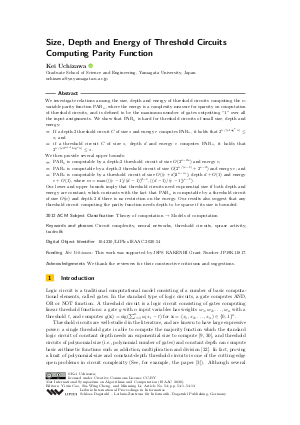@InProceedings{uchizawa:LIPIcs.ISAAC.2020.54,
author = {Uchizawa, Kei},
title = {{Size, Depth and Energy of Threshold Circuits Computing Parity Function}},
booktitle = {31st International Symposium on Algorithms and Computation (ISAAC 2020)},
pages = {54:1--54:13},
series = {Leibniz International Proceedings in Informatics (LIPIcs)},
ISBN = {978-3-95977-173-3},
ISSN = {1868-8969},
year = {2020},
volume = {181},
editor = {Cao, Yixin and Cheng, Siu-Wing and Li, Minming},
publisher = {Schloss Dagstuhl -- Leibniz-Zentrum f{\"u}r Informatik},
address = {Dagstuhl, Germany},
URL = {https://drops.dagstuhl.de/entities/document/10.4230/LIPIcs.ISAAC.2020.54},
URN = {urn:nbn:de:0030-drops-133988},
doi = {10.4230/LIPIcs.ISAAC.2020.54},
annote = {Keywords: Circuit complexity, neural networks, threshold circuits, sprase activity, tradeoffs}
}

 Creative Commons Attribution 3.0 Unported license
Creative Commons Attribution 3.0 Unported license






























